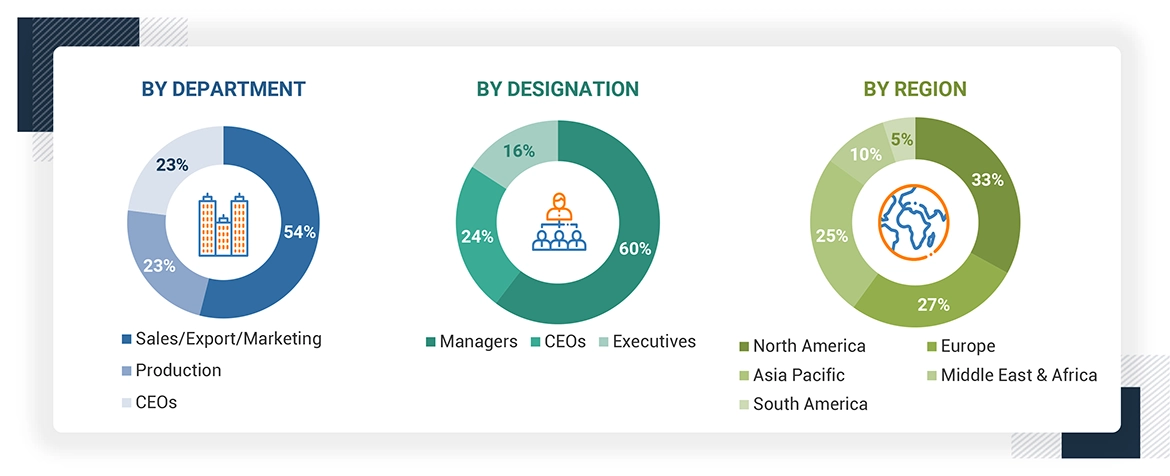The study involved four major activities for estimating the current global size of the silanes market. Exhaustive secondary research was conducted to gather information on the market, the peer market, and the parent market. The next step was to validate these findings, assumptions, and sizes with the industry experts across the value chain of silanes through primary research. Both the top-down and bottom-up approaches were employed to estimate the overall size of the silanes market. After that, market breakdown and data triangulation procedures were used to determine the size of different segments and sub-segments of the market.
Secondary Research
In the secondary research process, various secondary sources such as Business Standard, Bloomberg, World Bank, and Factiva were referred to, to identify and collect information for this study on the silanes market. These secondary sources included annual reports, press releases & investor presentations of companies, white papers, certified publications, articles by recognized authors, regulatory bodies, trade directories, and databases.
Primary Research
Various primary sources from both the supply and demand sides of the silanes market were interviewed to obtain qualitative and quantitative information. The primary sources from the supply side included industry experts, such as Chief Executive Officers (CEOs), vice presidents, marketing directors, sales professionals, and related key executives from various leading companies and organizations operating in the silanes industry. The breakdown of the profiles of primary respondents is as follows:

Notes: Companies are classified based on their revenue–Tier 1 = >USD 7 billion, Tier 2 = USD 500 million to USD 7 billion, and Tier 3 = < USD 500 million.
Others include sales, marketing, and product managers.
To know about the assumptions considered for the study, download the pdf brochure
Market Size Estimation
Both the top-down and bottom-up approaches were used to estimate and validate the global size of the silanes market. These approaches were also used extensively to estimate the size of various dependent segments of the market. The research methodology used to estimate the market size included the following details:
-
The key players were identified through extensive secondary research.
-
The industry’s supply chain and market size, in terms of value, were determined through primary and secondary research processes.
-
All percentage shares, splits, and breakdowns were determined using secondary sources and verified through primary sources.
-
All possible parameters that affect the markets covered in this research study were accounted for, viewed in extensive detail, verified through primary research, and analyzed to obtain the final quantitative and qualitative data.
-
The research includes the study of reports, reviews, and newsletters of key industry players, along with extensive interviews with key officials, such as directors and marketing executives.

Data Triangulation
After arriving at the overall market size from the estimation process explained above, the total market was split into several segments and sub-segments. The data triangulation and market breakdown procedures were employed, wherever applicable, to complete the overall market engineering process and arrive at the exact statistics for all segments and sub-segments of the silanes market. The data was triangulated by studying various factors and trends from both the demand- and supply-side.
In addition, the market size was validated by using both the top-down and bottom-up approaches. Then, it was verified through primary interviews. Hence, for every data segment, there are three sources—top-down approach, bottom-up approach, and expert interviews. The data were assumed to be correct when the values arrived at from the three sources matched.
Market Definition
Silanes, also known as silicon hydrides, are compounds made up of silicon and hydrogen through covalent bonds. They can be produced by reacting magnesium silicide with acids or by reducing silicon chlorides with lithium aluminum hydride. Silanes come in two types: functional and non-functional. Functional silanes are useful when reactions with both inorganic and organic substances are needed, while non-functional silanes are effective with only inorganic materials. They serve various roles such as crosslinking agents, adhesion promoters, surface modifiers, coupling agents, and dispersing agents.
Stakeholders
-
Silanes Manufacturers
-
Silanes Suppliers
-
Raw Material Suppliers
-
Research & development entities
-
Industry associations and regulatory bodies
-
End Users
Report Objectives
-
To estimate and forecast the silanes market, in terms of value and volume
-
To provide detailed information about the major factors (drivers, restraints, opportunities, and challenges) influencing the market growth
-
To define, describe, and forecast the market size, based on type, application, end-use industry, and region
-
To forecast the market size along with segments and submarkets, in key regions: North America, Europe, Asia Pacific (APAC), Middle East & Africa (MEA), and South America along with their key countries
-
To strategically analyze micro markets, for individual growth trends, prospects, and their contribution to the total market
-
To analyze growth opportunities in the market for stakeholders and provide details on the competitive landscape for market leaders
-
To strategically profile key players and comprehensively analyze their market shares and core competencies
-
To analyze competitive developments, such as merger & acquisition, expansion & investment, and agreements in the silanes market



Maureen
Dec, 2017
Silanes market report and in-depth information on production volume.
Andres
Nov, 2015
Canadian Silanes market size, segments etc..
Candela
Apr, 2019
Report on silanes.
Roberto
Aug, 2017
Detailed market view of Europe..